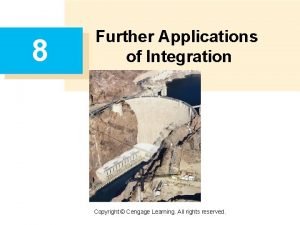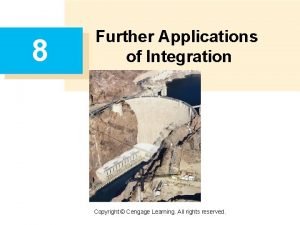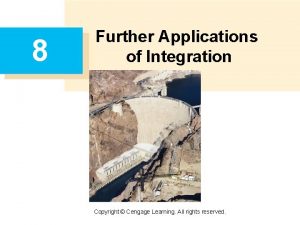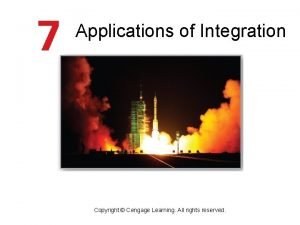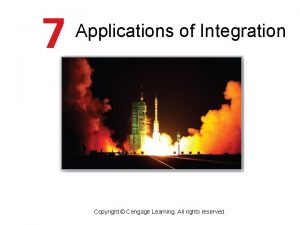8 Further Applications of Integration Copyright Cengage Learning
























- Slides: 24

8 Further Applications of Integration Copyright © Cengage Learning. All rights reserved.

8. 2 Area of a Surface of Revolution Copyright © Cengage Learning. All rights reserved.

Area of a Surface of Revolution A surface of revolution is formed when a curve is rotated about a line. Such a surface is the lateral boundary of a solid of revolution. We want to define the area of a surface of revolution in such a way that it corresponds to our intuition. If the surface area is A, we can imagine that painting the surface would require the same amount of paint as does a flat region with area A. 3

Area of a Surface of Revolution Let’s start with some simple surfaces. The lateral surface area of a circular cylinder with radius r and height h is taken to be A = 2 rh because we can imagine cutting the cylinder and unrolling it (as in Figure 1) to obtain a rectangle with dimensions 2 r and h. Figure 1 4

Area of a Surface of Revolution Likewise, we can take a circular cone with base radius r and slant height l, cut it along the dashed line in Figure 2, and flatten it to form a sector of a circle with radius l and central angle = 2 r l. Figure 2 5

Area of a Surface of Revolution We know that, in general, the area of a sector of a circle with radius l and angle is l 2 and so in this case the area is Therefore we define the lateral surface area of a cone to be A = r l. What about more complicated surfaces of revolution? If we follow the strategy we used with arc length, we can approximate the original curve by a polygon. 6

Area of a Surface of Revolution When this polygon is rotated about an axis, it creates a simpler surface whose surface area approximates the actual surface area. By taking a limit, we can determine the exact surface area. The approximating surface, then, consists of a number of bands, each formed by rotating a line segment about an axis. 7

Area of a Surface of Revolution To find the surface area, each of these bands can be considered a portion of a circular cone, as shown in Figure 3 8

Area of a Surface of Revolution The area of the band (or frustum of a cone) with slant height l and upper and lower radii r 1 and r 2 is found by subtracting the areas of two cones: A = r 2(l 1 + l ) – r 1 l 1 = [(r 2 – r 1) l 1 + r 2 l ] From similar triangles we have which gives r 2 l 1 = r 1 l 1 + r 1 l or (r 2 – r 1)l 1 = r 1 l 9

Area of a Surface of Revolution Putting this in Equation 1, we get A = (r 1 l + r 2 l ) or where r = (r 1 + r 2) is the average radius of the band. 10

Area of a Surface of Revolution Now we apply this formula to our strategy. Consider the surface shown in Figure 4, which is obtained by rotating the curve y = f (x), a x b, about the x-axis, where f is positive and has a continuous derivative. (a) Surface of revolution (b) Approximating band Figure 4 11

Area of a Surface of Revolution In order to define its surface area, we divide the interval [a, b] into n subintervals with endpoints x 0, x 1, . . . , xn and equal width x, as we did in determining arc length. If yi = f (xi ), then the point Pi(xi, yi ) lies on the curve. The part of the surface between xi – 1 and xi is approximated by taking the line segment Pi – 1 Pi and rotating it about the x -axis. 12

Area of a Surface of Revolution The result is a band with slant height l = | Pi – 1 Pi | and average radius r = (yi – 1 + yi) so, by Formula 2, its surface area is As in the proof, We have where xi is some number in [xi – 1, xi ]. 13

Area of a Surface of Revolution When x is small, we have yi = f (xi) f (xi ) and also yi – 1 = f (xi – 1) f (xi ), since f is continuous. Therefore and so an approximation to what we think of as the area of the complete surface of revolution is 14

Area of a Surface of Revolution This approximation appears to become better as n and, recognizing (3) as a Riemann sum for the function g(x) = 2 f (x) , we have Therefore, in the case where f is positive and has a continuous derivative, we define the surface area of the surface obtained by rotating the curve y = f (x), a x b, about the x-axis as 15

Area of a Surface of Revolution With the Leibniz notation for derivatives, this formula becomes If the curve is described as x = g(y), c y d, then the formula for surface area becomes 16

Area of a Surface of Revolution Now both Formulas 5 and 6 can be summarized symbolically, using the notation for arc length, as For rotation about the y-axis, the surface area formula becomes where, as before, we can use either or 17

Area of a Surface of Revolution These formulas can be remembered by thinking of 2 y or 2 x as the circumference of a circle traced out by the point (x, y) on the curve as it is rotated about the x-axis or y-axis, respectively (see Figure 5). (b) Rotation about y-axis: S = ∫ 2 x ds (a) Rotation about x-axis: S = ∫ 2 y ds Figure 5 18

Example 1 The curve y = x 2 + y 2 = 4. , – 1 x 1, is an arc of the circle Find the area of the surface obtained by rotating this arc about the x-axis. (The surface is a portion of a sphere of radius 2. See Figure 6. ) Figure 6 19

Example 1 – Solution We have and so, by Formula 5, the surface area is 20

Example 1 – Solution = 4 cont’d 1 dx = 4 (2) = 8 21

Example 3 Find the area of the surface generated by rotating the curve y = ex, 0 x 1, about the x-axis. Solution: Using Formula 5 with y = ex and = ex we have 22

Example 3 – Solution cont’d (where u = ex) (where u = tan and = tan– 1 e) = [sec tan + ln(sec + tan ) – – ln( + 1)] 23

Example 3 – Solution cont’d Since tan = e, we have sec 2 = 1 + tan 2 = 1 + e 2 and 24
 Further applications of integration
Further applications of integration Further applications of integration
Further applications of integration Further applications of integration
Further applications of integration Further applications of integration
Further applications of integration Further applications of integration
Further applications of integration Further applications of integration
Further applications of integration Cengage chapter 7
Cengage chapter 7 Delmar cengage learning medical terminology
Delmar cengage learning medical terminology Cengage learning heart diagram
Cengage learning heart diagram Cengage learning heart diagram
Cengage learning heart diagram South-western cengage learning
South-western cengage learning 2009 delmar cengage learning
2009 delmar cengage learning 2009 delmar cengage learning
2009 delmar cengage learning Cengage learning heart diagram
Cengage learning heart diagram Medical terminology chapter 1 answer key
Medical terminology chapter 1 answer key Cengage learning australia
Cengage learning australia 2009 delmar cengage learning
2009 delmar cengage learning Cengage learning
Cengage learning Cengage learning
Cengage learning Wadsworth cengage learning
Wadsworth cengage learning Cengage learning
Cengage learning Cengage learning plant cell
Cengage learning plant cell Cengage learning
Cengage learning Cengage learning
Cengage learning Brooks cole cengage learning
Brooks cole cengage learning




























